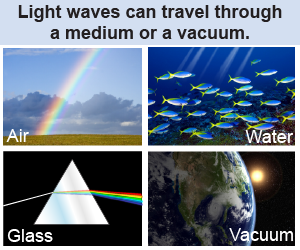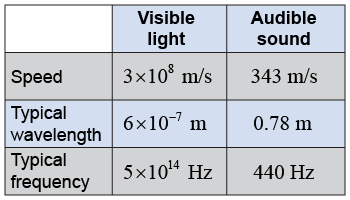|
 Light waves can travel through many gases, liquids, and solids, such as air, glass, and water. Light can also travel through the vacuum of empty space. The ability to propagate in a vacuum makes light waves different from sound waves, which require matter (such as air) to propagate. The speed of sound can be estimated by timing an echo with a stopwatch. In contrast, it takes sensitive experiments to detect any effects of light’s finite speed. Light and sound have very different characteristic speeds, wavelengths, and frequencies.
Light waves can travel through many gases, liquids, and solids, such as air, glass, and water. Light can also travel through the vacuum of empty space. The ability to propagate in a vacuum makes light waves different from sound waves, which require matter (such as air) to propagate. The speed of sound can be estimated by timing an echo with a stopwatch. In contrast, it takes sensitive experiments to detect any effects of light’s finite speed. Light and sound have very different characteristic speeds, wavelengths, and frequencies. 
|
 If you compare light and sound, you notice that light travels far faster than sound. The wavelength of visible light is the size of atoms whereas the wavelength of sound is the size of macroscopic objects. The frequency of light is trillions of hertz compared to audible sound, which ranges from 20 to 20,000 Hz.
If you compare light and sound, you notice that light travels far faster than sound. The wavelength of visible light is the size of atoms whereas the wavelength of sound is the size of macroscopic objects. The frequency of light is trillions of hertz compared to audible sound, which ranges from 20 to 20,000 Hz. 
|
The frequency, wavelength, and speed of light are related by equation (22.1), which is similar to the relationship for other waves. The speed of light (or c) is the product of frequency and wavelength. 
|
| (22.1) | | | c | = | speed of light (m/s) = 3.00×108 m/s in a vacuum | | f | = | frequency (Hz) | | λ | = | wavelength (m) |
| Speed of light
|
|
The speed of light is usually assumed to be in a vacuum, e.g., in outer space where there is no air or other gas. Just as the speed of sound changes depending on the material it is traveling through (such as air or water in the ocean), the speed of light differs when it travels through different materials. Light travels slightly slower when it passes through air and significantly slower in water. But the frequency of the light stays the same, even when it travels from one material to another. 
|
Calculate the frequency of visible light (in a vacuum) if the wavelength is 500 nm. | Asked: | frequency f of the light | | Given: | wavelength of the light, λ = 500 nm; speed of light, c = 3×108 m/s | | Relationships: | c = f λ | | Solution: | Solve for frequency by dividing both sides by λ: Convert nanometers to meters: | |
Calculate the answer: | |
| 
|
What is the wavelength of an x-ray traveling with a frequency of 3×1018 Hz? - 10−26 m
- 10−10 m
- 1010 m
- 1026 m
 |
The correct answer is b, 10−10 m. Use λ = c/f. 
|

